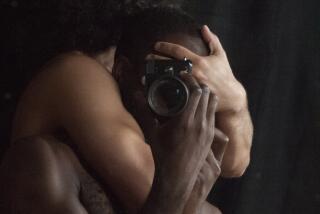Raul Corrales, 81; Photographer Captured the Cuban Revolution
- Share via
Raul Corrales, a Cuban photographer who documented the country’s political revolution of the 1950s in bold and poetic images, died April 15, according to Darrel Couturier, his Los Angeles art dealer. He was 81.
Corrales died of a heart attack at his home in Cojimar, a fishing village near Havana, Couturier said.
“He documented one of the most important events in 20th century history,” Couturier said this week.
“Corrales was political, but there is also a romance in his work,” said Constantine Grimaldis, owner of the C. Grimaldis Gallery in Baltimore, who exhibited Corrales’ work in a 2002 show curated by Couturier.
Perhaps Corrales’ best-known photograph is a view of Cuban revolutionaries riding toward the camera on horseback, straw hats on their heads, flags lifted high. The work has the grandeur and bravado of a history painting. It became an icon of the revolution.
He took many of his photographs while working for Cuban magazines in the 1940s and 1950s, and for Revolucion, the new government newspaper, starting in 1959. That year the country’s dictator, Fulgencio Batista, fled the country and Fidel Castro’s forces took control.
His best-known images of the leaders of the revolution include a photograph of Castro hiking in the Sierra Maestra mountains and one of Che Guevara, smoking and smiling. Several of his photographs became popular postcards in Cuba.
Other well-known works by Corrales are his portraits of the ordinary men who became revolutionaries, their faces full of character.
One image captures the optimism of the rebels. Taken from above, it consists of a sea of hats and guns.
Corrales’ main rival among Cuba’s photographers in the revolutionary era was his friend Alberto Diaz Gutierrez, known as Korda, whose portrait of Che, solemn and intent, became world famous. It was used on Cuban currency and appeared on billboards.
Korda, who died in 2001, was three years older than Corrales but referred to him as his teacher.
“With the death of Korda and now of Corrales, it is the passing of an era,” Grimaldis said.
He described Corrales as a man with a great sense of humor and “the relaxed attitude of someone who knows who he is and what he has done.”
While the Cuban revolution was Corrales’ finest moment as a photographer, he is also known for other images. He photographed Ernest Hemingway when the two men went fishing. They caught nothing, but Corrales came back with a photograph of Hemingway in a rowdy pose.
Born in Ciego de Avila, Cuba, Corrales moved to Havana with his family as a boy. He worked at a cafe, greeting customers and selling newspapers and magazines.
He liked to look at the photography magazines and was particularly interested in the work of American photojournalist Margaret Bourke-White.
“I wanted to be a photographer ever since I was a kid,” Corrales said in a 1997 interview with the Dallas Morning News.
His first camera was an inexpensive plastic model. “I used to go into the streets and take pictures of things I liked,” he said.
He was a self-taught photographer and got his first job in the mid-1940s working for two newspapers run by the Socialist Party.
He covered a number of political protests and was harassed several times by political bosses who supported Batista.
“Corrales’ picture of Castro’s triumphant entry into Havana at the head of a ragtag rebel army packs the emotional punch of such images as Washington crossing the Delaware,” wrote a reviewer for the Baltimore Sun in 2002.
Once Castro was in power, Corrales traveled with him as a photojournalist on several occasions, including a trip to Venezuela.
In 1962 Corrales was named director of Cuba’s Office of Historical Matters, which houses the government archive of the revolution.
He remained there until he retired in 1991.
Corrales’ survivors include his wife, Norma, and three children.
More to Read
Sign up for Essential California
The most important California stories and recommendations in your inbox every morning.
You may occasionally receive promotional content from the Los Angeles Times.













